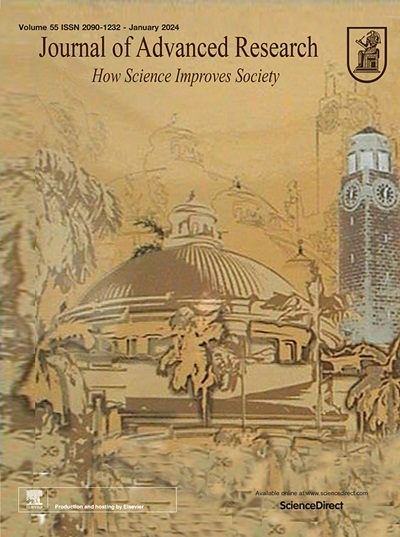血红素加氧酶1 (HO-1)是逆转非小细胞肺癌顺铂耐药的药物靶点
IF 11.4
1区 综合性期刊
Q1 MULTIDISCIPLINARY SCIENCES
引用次数: 0
摘要
铂类药物是临床肿瘤学中应用最广泛的化疗药物,长期以来一直面临着耐药问题,迫切需要解决。鉴定耐药生物标志物有助于降低铂类药物耐药,提高治疗效果。目的本研究旨在确定非小细胞肺癌(NSCLC)顺铂耐药发展相关的潜在生物标志物,并探索克服化疗耐药的机制。方法构建snsclc顺铂耐药细胞系,并进行转录组测序。结果通过Gene Expression Omnibus (GEO)和The Cancer Genome Atlas (TCGA)数据库进行验证。通过分子对接、蛋白质组学测序、体外和体内实验等方法评估血红素加氧酶1 (HMOX1)在顺铂耐药中的作用。结果在snsclc顺铂耐药细胞株中,GEO和TCGA数据证实Nrf2下游的HMOX1是顺铂诱导的关键耐药基因。研究发现Nrf2/HO-1通路的激活可诱导铁下沉耐药,这是顺铂耐药的关键机制。候选化合物SB 202190和北二氢愈木酸(NDGA)通过抑制HO-1有效地重新激活铁下垂,从而增加顺铂敏感性。结论Nrf2/HMOX1通路在非小细胞肺癌顺铂耐药中起重要作用。SB 202190和NDGA靶向HO-1是克服耐药和改善化疗结果的有希望的策略。本文章由计算机程序翻译,如有差异,请以英文原文为准。

Heme oxygenase 1 (HO-1) is a drug target for reversing cisplatin resistance in non-small cell lung cancer
Introduction
Platinum-based drugs, the most widely used chemotherapeutic drugs in clinical oncology, have long faced the problem of drug resistance, which is urgently in need of resolution. Identifying biomarkers of drug resistance may help reduce platinum resistance and improve therapeutic efficacy.Objectives
This study aims to identify potential biomarkers associated with the development of cisplatin resistance in non-small cell lung cancer (NSCLC) and explore mechanisms to overcome chemoresistance.Methods
NSCLC cisplatin resistance cell lines were constructed, and transcriptome sequencing was performed. Results were validated using Gene Expression Omnibus (GEO) and The Cancer Genome Atlas (TCGA) databases. Molecular docking, proteomics sequencing, and in vitro and in vivo experiments were conducted to evaluate the role of Heme Oxygenase 1 (HMOX1) in cisplatin resistance.Results
NSCLC cisplatin resistance cell lines, GEO and TCGA data identified HMOX1, downstream of Nrf2, as a key drug resistance gene induced by cisplatin. Activation of the Nrf2/HO-1 pathway was found to induce ferroptosis resistance, a critical mechanism of cisplatin resistance. Candidate compounds SB 202190 and Nordihydroguaiaretic acid (NDGA) effectively reactivated ferroptosis by inhibiting HO-1, thereby increasing cisplatin sensitivity.Conclusion
The Nrf2/HMOX1 pathway is a significant contributor to cisplatin resistance in NSCLC. Targeting HO-1 with SB 202190 and NDGA presents a promising strategy to overcome resistance and improve chemotherapy outcomes.求助全文
通过发布文献求助,成功后即可免费获取论文全文。
去求助
来源期刊

Journal of Advanced Research
Multidisciplinary-Multidisciplinary
CiteScore
21.60
自引率
0.90%
发文量
280
审稿时长
12 weeks
期刊介绍:
Journal of Advanced Research (J. Adv. Res.) is an applied/natural sciences, peer-reviewed journal that focuses on interdisciplinary research. The journal aims to contribute to applied research and knowledge worldwide through the publication of original and high-quality research articles in the fields of Medicine, Pharmaceutical Sciences, Dentistry, Physical Therapy, Veterinary Medicine, and Basic and Biological Sciences.
The following abstracting and indexing services cover the Journal of Advanced Research: PubMed/Medline, Essential Science Indicators, Web of Science, Scopus, PubMed Central, PubMed, Science Citation Index Expanded, Directory of Open Access Journals (DOAJ), and INSPEC.
 求助内容:
求助内容: 应助结果提醒方式:
应助结果提醒方式:


